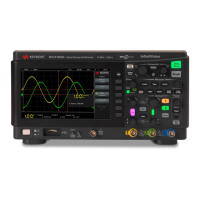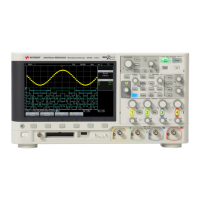40 Keysight InfiniiVision DSOX1204A/G Oscilloscopes User's Guide
2 Quick Reference
FFT Spectral Analysis
FFT is used to compute the fast Fourier transform using analog input channels.
FFT takes the digitized time record of the specified source and transforms it to the
frequency domain.
When the FFT function is selected, the FFT spectrum is plotted on the oscilloscope
display as magnitude in dBV versus frequency. The readout for the horizontal axis
changes from time to frequency (Hertz) and the vertical readout changes from
volts to dB.
Use the FFT function to find crosstalk problems, to find distortion problems in
analog waveforms caused by amplifier non-linearity, or for adjusting analog filters.
FFT Measurement Hints
The number of points acquired for the FFT record can be up to 65,536, and when
frequency span is at maximum, all points are displayed. Once the FFT spectrum is
displayed, the frequency span and center frequency controls are used much like
the controls of a spectrum analyzer to examine the frequency of interest in greater
detail. Place the desired part of the waveform at the center of the screen and
decrease frequency span to increase the display resolution. As frequency span is
decreased, the number of points shown is reduced, and the display is magnified.
While the FFT spectrum is displayed, use the [FFT] and [Cursors] keys to switch
between measurement functions and frequency domain controls in FFT Menu.
Table 7 FFT Features
Feature Front Panel Key/Softkey Location (see built-in help for more information)
FFT span/center [FFT] > Span
[FFT] > Center
FFT window [FFT] > Settings > Window (Hanning, Flat Top, Rectangular, Blackman Harris, see also "FFT
Spectral Leakage" on page 43)
FFT vertical units [FFT] > Settings > Vertical Units (Decibels, VRMS)
FFT auto setup [FFT] > Settings > Auto Setup
FFT waveform, scale [FFT], turn the Math vertical scale knob
FFT waveform, offset [FFT], turn the Math vertical position knob

